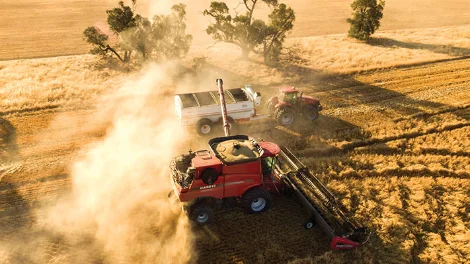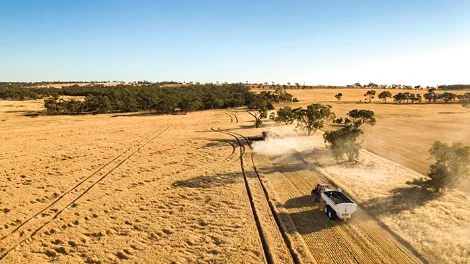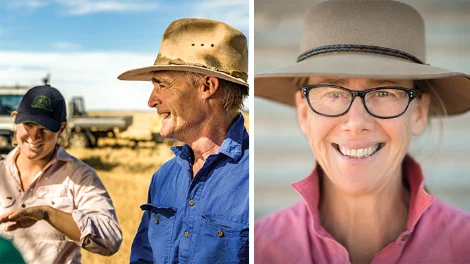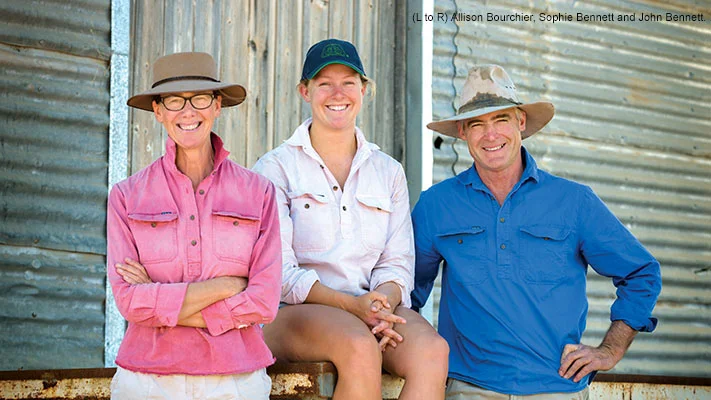



John Bennett and Allison Bourchier along with their two children Sophie and Hamish reside on the family farm in the West Wimmera, Victoria.
PROPERTY LOCATION
Lawloit is half way between Nhill and Kaniva in the West Wimmera, Victoria
OWNERS/MANAGERS
John Bennett and Allison Bourchier, plus daughter Sophie (23), and son Hamish (21).
COMMUNITY INVOLVEMENT
John is the current Chair of the GRDC Southern Panel, and a previous grower representative.
The family is involved with the Kaniva Leeor Football and
Netball Club.
FARM DETAILS
80 per cent owned
20 per cent leased
75 per cent cropping
25 per cent livestock
RAINFALL
Annual district average: 450mm
SOIL TYPES
Highly variable including Wimmera self-mulching clays, sodic red soil, and deep sands.
CROPS GROWN
Wheat and barley (40 per cent), canola (25 per cent), legumes (20 per cent), green manure (15 per cent).
LIVESTOCK
Merino ewes are purchased annually.
EMPLOYEES
Three full time staff – Mike, Jack and Troy, plus casuals at harvest.
PROPERTY LOCATION
Lawloit is half way between Nhill and Kaniva in the West Wimmera, Victoria.
Q. When was the farming district settled?
A. Lawloit was established in the early 1860s as a staging post and hotel on the gold escort route between the Victorian gold fields and Adelaide. By the late 1860s, it was opened up for grazing and cropping.
Q. What is the history of your farm?
A. In 1995, we both left our family farming enterprises in the Wimmera to create our own business. I was from north of Nhill and Allison was from Goroke. We purchased Lawloit in 2002. Around 20 per cent of our operation is leased. Leasing land has helped us grow our business, and we have worked hard to create strong relationships with the owners.
Q. How do you manage your cropping program?
A. Timeliness around sowing is our first and foremost management consideration, and allows us to extract the maximum value from all our other inputs, as well as utilise our plant’s available water. We aim to keep things as simple as possible so we can carry out our operations on time. Paying attention to detail is also very important.
Q. Rotation?
A. Wheat and canola are our most profitable rotation, and legumes and barley fit in around that. The canola wheat component of the rotation is also very good for cleaning up disease and tackling grass weed issues.
Q. Weed control?
A. We like to make sure paddocks are very clean before commencing the cropping phase. We green or brown manure vetch, spray top a pasture, or grow hay for two or three consecutive years to achieve this. This avoids having to use expensive herbicides to tidy up weeds in the cropping phase, and also means we can dry sow without a big weed burden.
We are focused on a profitable rotation, but weeds dictate our rotation in a lot of paddocks. Our main weed issues are grasses, particularly ryegrass and brome grass. Barley grass is also becoming an emerging issue. Summer weed control has been a game changer. Soil moisture is money in the bank, and summer rainfall events are very important to us. We are fanatical about maintaining that moisture by controlling summer weeds. It lets us grow crops in dry years.
Q. How do you manage resistance to herbicides and fungicides?
A. We rely on glyphosate for summer weed control, so we’re conscious of the number of times we use glyphosate in our rotation, and are always implementing different strategies to ensure its longevity. We’re not afraid to take a paddock out of production to clean it up, either with hay, pasture or brown manure vetch. When we’re using glyphosate in a fallow situation, we graze sheep on that country to make sure nothing goes to seed. We also do a double knock if there is an issue.
Since 2016 we have had to spray for Septoria, which brings another level of complexity to our fungicide strategy because Septoria is prone to developing resistance to fungicide. We are very conscious of having a fungicide strategy that doesn’t develop resistance, by using different modes of action at the right time.
Q. Which grain varieties work best in your area?
A. Our main current wheat varieties are Sceptre and Beckom. We are using imi-tolerant and TT canola varieties. GM canola is a good tool, but we haven’t needed to grow it at this stage.
Q. What are your tillage practices?
A. We are predominantly no-till and use interrow sowing, which has significantly improved our ability to handle stubble loads. The soil moisture conservation from this practice has been a major benefit over the last two to three years.
Q. What is your fertiliser regime?
A. We are very fussy about our fertiliser application. We test a lot of representative paddocks for deep soil nitrogen and moisture in autumn. Then, based on the starting point for nitrogen, we develop a nitrogen calculator throughout the year. We track rainfall and soil moisture and the growth rate of crops to build our nitrogen strategy.
Twenty years ago we used a lot of nitrogen up front in one application, but now we apply smaller amounts of nitrogen at specific times of the year. We generally put about 20 kilograms of starter nitrogen down the tube at sowing on our cereals, and then come back and apply nitrogen during the growing season.
This gives us the flexibility to make decisions about nitrogen application once the rainfall decile (average, below average or above average) has become more apparent. We basically aim to make the most of all available moisture. We don’t put nitrogen down the tube with canola to avoid toxicity in the seed row. If there is a specific problem in a paddock, we will do a full soil test. In the past, potassium and copper have been spread prior to sowing. We will put out sulphur as gypsum on sodic country and ahead of canola.
Q. What is your harvesting routine?
A. We have our own harvesting equipment, but also use local harvest contractor BJ Hawker. We use our trucks for transport to our on-farm storage and for delivery to the local receival site at Nhill, but contractors are used mostly for long distance freight. Legumes are delivered to accumulators in the Wimmera. This year, beans have been delivered to Viterra’s site at Dooen.
Q. Do you have on-farm storage?
A. We have increased our on-farm storage in recent years and can now store 60 per cent of our grain. This gives us flexibility, and evens out the seasonal and financial ups and downs of the business. It also drought proofs our livestock operation and enables us to carry grain into the following financial year.
Q. Tell us about your grain marketing program
A. We are really focused on doing the day-today work that grows the crop, so we employ people to provide good marketing advice.
We use a grain broker for advice about our cereals and canola. They work with us to develop a strategy and we are able to assess our risk at any given time. We get daily price updates from the broker and speak to them on a regular basis.
We have become more conservative when it comes to forward selling of physical contracts over time. Since 2007, we have worked on minimum crop estimates to calculate our forward selling strategy as the growing season progresses. In good years, when you have the luxury of high production, it is easier to make marketing decisions. In drought years, excessive forward selling can bring you unstuck. For us, it is really important to know how the season is unfolding before committing grain to forward sales.
We really like options because they are just a form of insurance with a set cost, unlike other forms of hedging which can get out of control. It might cost you $15-$18/tonne but you have protected the price. We generally use local brokers for our legumes as there is a strong buying presence in the Horsham region. Our on-farm storage is an important part of our grain marketing strategy. It gives us a buffer against bad years and the ability to spread income into the next season.
Q. What are the biggest challenges/risks to your farm business?
A 1. Maintaining the standard of management we aspire to, given the increasing size of the farm and increasing level of complexity in the office and paddock.
2. Cost of machinery.
3. Operating in an environment where social pressures are becoming an increasing consideration. We cannot afford for consumers to doubt the science and to trust the fake news – for example, the argument about glyphosate last year.
4. Sourcing good staff.
Q. How do you try to manage those challenges/risks?
A 1. We try to keep things simple.
2. It has taken us a long time to build up our plant. We are very conscious of keeping machinery costs low and generally buy good quality second hand machinery. We are particular about good maintenance and having gear ready to go when we need it. We are not afraid to use contractors.
3. Our industry needs to be smart, and get ahead of this social pressure in a positive, constructive way. We need to show that agriculture provides many benefits to the world – not just producing food, but also things like sequestering carbon.
4. We are lucky to have three great employees – Mike McCabe, Jack Bone and Troy Walton. They can all multi-task but they also have a specific area they focus on, which gives them a higher level of expertise and additional job satisfaction. We value all our staff highly.
Q. What technological developments do you foresee which will improve your family farm?
A. Sensing technology has the potential to help us maintain a high standard of management as farms grow in size. It will enable us to keep a footprint in the paddock, and keep track of weeds and plant growth without having to drive over every acre. At the moment, the cost of sensing technology is prohibitive, but like autosteer, there will be a time where the cost is reduced to a point that it provides a practical outcome.
Q. Would you shift to another district for cheaper land, or if rainfall becomes a problem, due to climate change?
A. Yes, we would. We have moved to take opportunities in the past. We purchased this property because the rainfall was better and seasons more reliable. We are confident that through technological and breeding advancements we can stay in the game in drier years. Plus, we are fanatical about conserving soil moisture – that’s what enables us to grow decent crops in dry years.
Q. Tell us about your sheep enterprise
A. Stock has always been an important part of the business, and Allison and Sophie manage the sheep enterprise. Merino ewes with good genetics are bought each year. Most are crossed with White Suffolk rams, but most recently a number have been crossed with Merino rams because the Merino wool prices are so strong.
Prime lambs are fattened on bean stubbles and turned off at around 22 kilograms domestically (sold via forward contracts on farm or through the livestock exchange in Horsham). Merino ewe lambs are retained for their self-replacing Merino flock, and Merino wethers are sold depending on seasonal conditions.
We run a very simple low-cost sheep operation that fits really well with our cropping enterprise. Sheep are great for picking off weed escapes after summer spraying, too.
Q. Do you think food production has a good future in Australia?
A. We are very confident in the future of farming. It is certainly a good time to be in agriculture, with good livestock prices and good grain prices. There are wonderful opportunities in agriculture in Australia. Australian famers have always had to be quick to adapt to stay in the game. Because we are not subsidised, as soon as something happens that is detrimental to our business, we get onto it. Land values are appreciating, which shows farmers are confident about re-investing in their businesses and industry.
Q. What is your retirement/succession plan?
A. We started succession planning some time ago. We worked with Kate Bourke from ThinkAgri to have a discussion with our children about where they wanted to be when they were 30. This was done independently of us. They were both keen to be involved in the farm, so we built our succession plan focusing on how to bring them into the business. We gave both children an option to purchase land when they turned 18, with assistance from us.
We decided getting them involved in the business early was a better option than waiting for us to hand over land when they are 50. This has helped them learn some valuable business skills and has given them self-confidence, ambition, and self-determination.